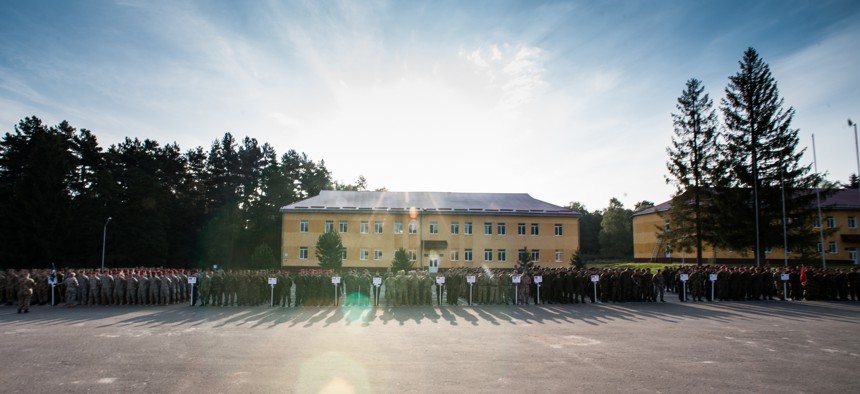
Soldiers from multiple nations stand in formation during Exercise Rapid Trident’s opening ceremony in Yavoriv, Ukraine, Sept. 15. U.S. Army photo by Spc. Joshua Leonard
It’s Time to Move US Forces Back to Europe
Basing troops abroad will increase their deterrence, make them readier to fight, and even save money.
The U.S. has recently beefed up its military presence in Europe, deploying an armored brigade combat team in January and an aviation brigade the following month. This a welcome reengagement with our European allies and a sharp signal to our potential adversaries — but the current and foreseeable security situation demands more than rotational presence. For military, political, and logistical reasons, it is time to return to large-scale, long-term, forward basing of U.S. forces.
The end of the Cold War led to massive reductions in the U.S. military posture in Europe.
These reductions were based not on an empirical or strategic review of U.S. force requirements in Europe, but rather on two factors: the opportunity to save money and the politically less contentious choice to close overseas military installations, not ones at home.
Meanwhile, many U.S. policymakers came to believe that Russia was on the road to democracy and a credible and worthy partner for the United States. The invasion of Georgia in 2008 should have changed that calculus. It did not. Instead, the Obama administration in 2009 launched its “reset” of relations with Russia. It failed. Nonetheless, in 2012 and 2013, the U.S. deactivated two brigade combat teams permanently stationed in Europe; it removed more than 10,500 soldiers and all U.S. main battle tanks from the continent.
Russia’s invasion of Ukraine in 2014 finally dissolved the Obama administration’s illusion of Moscow as a peaceful ally of the West. Thereafter, the U.S. sought to reengage with Europe, rushing through several policy U-turns, which included returning troops and funding to the European theatre. One month after Moscow annexed Crimea, for example, the U.S. launched Operation Atlantic Resolve to reassure our European allies, particularly those bordering Russia. This year, the U.S. has returned an armored brigade combat team to Europe — though the job is to be filled by Army units that rotate through every nine months. Similarly, the aviation brigade that arrived in February will be replaced in in November by a new rotational deployment of the 1st Air Cavalry Brigade.
We should do better.
Permanent forces provide a much greater deterrence value than rotational troops. Then-EUCOM Commander Philip Breedlove testified as much in 2015: “Permanently stationed forces are a force multiplier that rotational deployments can never match.” For one thing, they affirm the permanence of our commitment to our NATO allies. Other advantages were outlined in a recent editorial by Lt. Col. Joseph Goetz: Forward-stationed units aren’t just “ready,” they are “prepared”—and that’s an important distinction. Living, operating, and training where the fighting will occur is an advantage both our allies and adversaries enjoy. Forward-deployed forces enjoy that same advantage. Contrary to assertion, a rotational unit arriving in Europe is not more combat-ready solely because it had a training rotation in the Mojave Desert. Believing this discounts the complexity of coalition operations and the value of the knowledge gained by living and operating in the environment in which units are expected to fight.
Goetz also cites access to exercises; the cumulative knowledge gained through years of in-theatre exercises rather than mere months of drill; person-to-person contacts built with regional allies; and improved doctrinal, technical, and cultural interoperability with NATO standards and with our European allies.
Finally, there is the question of cost. A new U.S. Army War College study casts doubt on the assumption that rotational deployments are more cost-effective than permanent stationing of troops, particularly when the rotating units bring their heavy equipment to and from Europe.
Because the Russian invasion of the Ukraine is still fresh in their minds, U.S. lawmakers thus far have been willing to appropriate billions of dollars to fund the rotation of combat units for the European Deterrence Initiative (formerly the European Reassurance Initiative). In 2017, ERI was funded for over $3 billion. It is reasonable to expect that, in coming years, these funding requests will garner increased scrutiny, increasing the impetus to move to the more cost-effective practice of permanent basing.
The War College study also raised questions about the effect of rotational deployments on morale and military families. It found “strong anecdotal evidence to suggest that the shift from forward stationing to an Army that fulfills deterrence and reassurance missions through 9-month rotational deployments is having a detrimental effect on morale and family readiness.”
Supporters of rotational forces point to the benefits of having fully trained units prepared in the United States, deployed, and maintained as a cohesive entity throughout the cycle. However, these advantages are much more pronounced in areas like Korea, where because junior service members are not allowed to bring families and tours of duty are limited to one year. In those areas, forward-stationed units can experience turnover as high as 10 percent a month.
Conversely, a military tour of duty in a forward-stationed unit in Europe is typically three years, making turnover much easier to mitigate. The minor benefit that accompanies rotational force cohesion is more than outweighed by morale and cost factors.
When these factors are taken into consideration, it becomes clear that many of the assumptions in favor of rotational deployments stand on tenuous ground. As the Trump administration thinks through the best options to continue bolstering U.S. presence in Europe, it should consider the considerable advantages permanently based forces provide and station U.S. forces accordingly.
NEXT STORY: Democracy Remains the Best Path to Security




